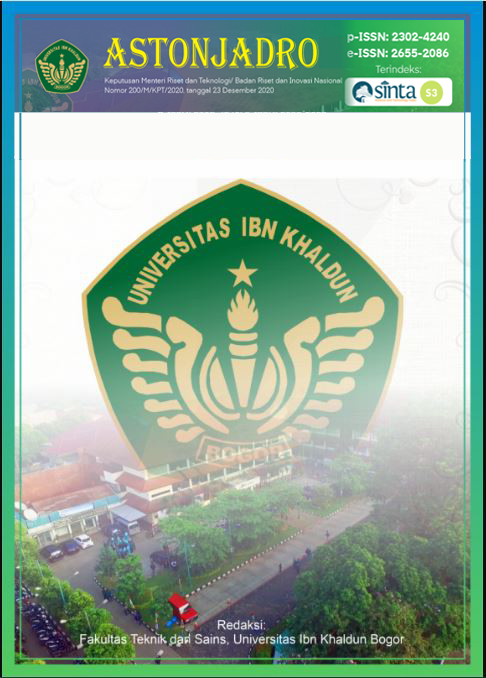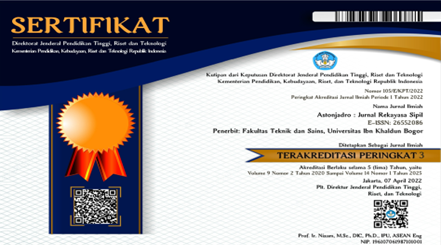Analysis of Road Damage Levels Using the SDI (Surface Distress Index) Method for Evaluation and Handling of Potholes
DOI:
https://doi.org/10.32832/astonjadro.v14i1.15015Keywords:
road damage; SDI method; flexible pavement; sample.Abstract
Highways are land transportation infrastructure that is very important in facilitating economic relations activities. The method used is the SDI (Surface Distress Index) method. The purpose of this study is to identify the types of road damage, analyze the level of road damage using the SDI method and evaluate the SDI value and handling potholes. The length of the road studied in this research is 1000 ± m which is divided into 10 segments with a segment length of 100 m each. The data required for this research is secondary data and primary data. Based on the results of processed field data, 6 types of road damage were obtained. The percentage results on Jalan Ciremai Ujung with an average SDI value of 34 and categorized as having a value in good and moderate conditions so that the percent value (%) in damaged conditions is 90%, moderate 10%, slightly damaged 0% and seriously damaged 0%. And carry out handling by means of routine maintenance on segments 1,2,3,5,6,7,8,9,10 and periodic maintenance on segment 10.
References
Direktorat Jenderal Bina Marga, 2011. Survei Kondisi Jalan untuk Pemeliharaan Rutin. 2 ed. Jakarta: Kementerian Pekerjaan Umum Direktorat Jenderal Bina Marga.
T., S. & Rulhendri, 2019. Evaluasi Tingkat Kerusakan Jalan pada Lapis Permukaan Ruas Jalan Tegar Beriman Kabupaten Bogor. Astonjadro, 8(2), pp. 70-79.
Rafiko Yahya, Mohamad Yusri bin Aman, Aji Suraji, Abdul Halim., 2019. Analisis Kerusakan Jalan Menggunakan Metode Pavement Condition Index (PCI) dan Surface Distress Index (SDI)”.
Cucup Muhammad Yusup, Tahadjudin, Nia Kartika., 2019. Analisis Biaya Pemeliharaan Terhadap Tingkat Kerusakan Jalan Menggunakan Metode Surface Distress Index (SDI) Studi Kasus: Ruas Jalan Cisaat–Situgunung Sta. 0+400 – 5+400 Kabupaten Sukabumi.
Irianto & Reny Rochmawati, 2020. Studi Penilaian Kondisi Kerusakan Jalan dengan Metode Nilai Internasional Roughness Index (IRI) dan Surface Distress Index (SDI). Jurnal Teknik, 13(2), pp. 07-15.
Gesvi Aptarila, Fadrizal Lubis, Alfian Saleh, 2020. Analisis Kerusakan Jalan Metode SDI Taluk Kuantan - Batas Provinsi Sumatera Barat. Sirklus jurnal teknik sipil, pp. 195 – 203.
Gusti Eri Fitriyadi, Komala Erwan, Elsa Tri Mukti, 2021. Analisis Kerusakan Permukaan Jalan Batas Kota Pontianak – Sungai Kakap Berdasarkan Metode Surface Distress Index (SDI).
Hendri Rahmat dan Widya Apriani., 2022. “Analisis Tingkat Kerusakan Jalan Dengan Metode Surface Distress Index (SDI). Jurnal Rab Construction Research 7 (1).
Nelly Iswanti Sembiring, Reynaldo Siahaan, Polin D. R. Naibaho., 2022. Analisis Kondisi Kerusakan Jalan Berastagi-Simpang Empat, Kabupaten Karo Dengan Menggunakan Metode SDI dan PCI. Jurnal Manajemen Riset dan Teknologi.
Sani Kurniawan, Muh Sarkowib, Trisya Septiana., 2022. Analisis Kerusakan Jalan Kabupaten Berdasarkan Surface Distress Index (SDI) Di Kecamatan Bahuga Kabupaten Way Kanan Provinsi Lampung. Jurnal Rekayasa Lampung.
Muhaimin, Winayati, Fitridawati Soehardi, 2022. Analisis Kerusakan Jalan Berdasarkan Metode Surface Distress Index (SDI) (Studi Kasus: Jalan Meranti Kota Pekanbaru Provinsi Riau)
Adelia Nur Annisa, Muhammad Naufal Nabil Fahsa, Edi Yusuf Adiman., 2023. Analisis Kondisi Perkerasan Jalan Menggunakan Metode SDI dan IRI (Studi Kasus: Ruas Jalan Bangau Sakti Kota Pekanbaru.
S Syaiful, H Rusfana. (2022). Rigid Pavement Planning in Traffic: Case Study in Ciherang Road and Pemuda Road, Bogor Regency, Indonesia. Journal of Applied Engineering Science, 1-13.
Syaiful, S., Yulianto, M., Murtejo, T., & Rulhendri, R. (2023). Analysis of the Function and Convenience of Pedestrian Public Transport Support the City of Bogor. ASTONJADRO, 12(3), 646–657. https://doi.org/10.32832/astonjadro.v12i3.4341
Syaiful, S., Damiana, S. L., & Prayudyanto, M. N. (2024). Analysis of the City Bus Service Network in Bogor City (Case Study: Bubulak Terminal - Cidangiang Route). ASTONJADRO, 13(3), 643–664. https://doi.org/10.32832/astonjadro.v13i3.14963
Malaiholo, D., Prihartanto, R., & Puruhita, H. W. (2024). Identification of the Causes Waste Material in the Railway Bridge Construction Project. ASTONJADRO, 13(2), 407–413. https://doi.org/10.32832/astonjadro.v13i2.14908
Paikun, P., & Perkasa, R. W. (2024). Analysis of Damage to Caringin Cikukulu Road, Sukabumi District Using the Pavement Condition Index (PCI) Method. ASTONJADRO, 13(3), 675–685. https://doi.org/10.32832/astonjadro.v13i3.15035
Tripradipta, R., Priyanto, S., Fahmi Amrozi, M. R., & Kemp, A. H. (2024). Analysis of Integrated Railway QR Code Mobile Payment Systems’ Technology Acceptance. ASTONJADRO, 13(3), 708–721. https://doi.org/10.32832/astonjadro.v13i3.15571
Brahmana, I. C. S., Hasibuan, G. C. R., & Anas, M. R. (2024). The Usage of Surface Distress Index (SDI) and Pavement Condition Index (PCI) to Evaluate The Condition of Jamin Ginting National Road (BTS. Medan City - BTS. Karo Regency). ASTONJADRO, 13(3), 922–929. https://doi.org/10.32832/astonjadro.v13i3.16028
Downloads
Published
How to Cite
Issue
Section
License
Copyright (c) 2025 ASTONJADRO

This work is licensed under a Creative Commons Attribution-ShareAlike 4.0 International License.
Paper submitted to ASTONJADRO is the sole property of the Astonjadro Journal. Unless the author withdraws the paper because he does not want to be published in this journal. The publication rights are in the journal Astonjadro.ASTONJADRO
LICENSE
This work is licensed under a Creative Commons Attribution-ShareAlike 4.0 International License.
Based on a work at http://ejournal.uika-bogor.ac.id/index.php/ASTONJADRO













